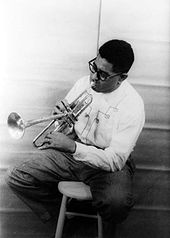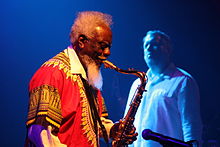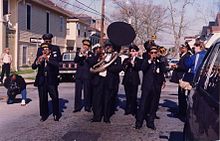Jazz
![]()
This article is about the music genre. For other meanings, see Jazz (disambiguation).
Jazz (pronunciation: [![]()
![]() d͡ʒɛːs] or [
d͡ʒɛːs] or [![]()
![]() jat͡s]) is a musical genre originating around 1900 in the southern states of the United States, originally produced predominantly by African Americans, which has been further developed in a variety of ways, often in crossover with other musical traditions and genres. In the meantime, forms of music that are often only loosely or barely connected to the African-American tradition are also counted as jazz.
jat͡s]) is a musical genre originating around 1900 in the southern states of the United States, originally produced predominantly by African Americans, which has been further developed in a variety of ways, often in crossover with other musical traditions and genres. In the meantime, forms of music that are often only loosely or barely connected to the African-American tradition are also counted as jazz.
In terms of its artistic significance, jazz is often understood as the American counterpart to European classical music. Beyond that, it has opened up new possibilities for almost all other genres of music, from pop to folk.

Louis Armstrong, one of the most important musicians of Hot Jazz with great influence on the further development of Jazz
Central jazz styles
→ Main article: History of jazz
With the increasing spread and popularization, first jazz criticism and then jazz research emerged. It understands jazz not only as a rousing entertainment music, but also as a serious cultural achievement. Thus, it contributed decisively to the appreciation and understanding of this music by a wider audience. In doing so, it prepared the ground for the developments that emerged from the 1940s onwards, which, like modern jazz, lay beyond popular music, to also find a worldwide audience. However, jazz criticism, with its categorizations and interpretations, often contradicted the musicians' different approach, which was predominantly influenced by African-American culture.
Jazz critics sketched out a series of jazz styles and interpreted their succession in such a way that the history of jazz built on the blues, gospel, and ragtime appeared, at least until the 1960s, as a roughly "consequential" development: New Orleans jazz/Dixieland jazz; Chicago jazz; swing; bebop; cool jazz/West Coast jazz; hard bop/East Coast jazz; free jazz; fusion/rock jazz. From about 1970 onwards, the variety of different styles grew considerably, and with it conflicting views of what was important in jazz, which developments were trend-setting, and which new musicians were to be regarded as significant. For the period from the 1970s onwards, it was therefore no longer possible to arrive at a generally accepted account of a stylistic development. Thus, several, partly different terms are used today for styles, currents and musical circles. Even the styles of the past are sometimes enriched with additional stylistic designations ("Latin jazz", "modal jazz") and evaluated differently from more recent perspectives. All these categorizations are fundamentally questioned by musicians, but also by jazz critics and researchers themselves. However, they have remained common for general orientation.
New Orleans Jazz (from 1905)
New Orleans jazz developed in New Orleans, Louisiana, in the early 20th century and spread to Chicago, Illinois, and New York through New Orleans bands in the 1910s. New Orleans jazz is often considered the first true jazz style. It was also the first music to be cited under the term jazz. Before 1917, the word jazz was often spelled "jass." Well-known exponents of New Orleans jazz were Kid Ory and Louis Armstrong, who was active in many different areas of jazz. The historical antecedent was the music of marching bands, church hymns, Negro spirituals and blues, as well as the cakewalk and ragtime. Its stylistic characteristics are: Collective improvisation, breaks, the trumpet as the main voice (played around by the other horns). In the 1950s, New Orleans jazz experienced a renaissance under the term New Orleans Revival.
Dixieland Jazz (from 1910)
Due to the racial segregation of the time, bands were segregated by skin color. In New Orleans, there were both African-American and white bands from the beginning. They often fought musical duels in the streets. Eventually, a white variety of New Orleans jazz emerged, Dixieland. The Original Dixieland Jass Band recorded its first shellac record on February 26, 1917, which was released in May 1917 and became a hit with millions. With it, jazz began to take hold around the world. With Dixieland, the original tone, grinding tones, expressive vibrato and overall expression took a back seat. The melodies were smoother, the harmonies purer, and the technique more accomplished. Dixieland jazz, however, cannot be sharply distinguished from New Orleans jazz. Over time, musicians played both styles regardless of the color of their skin. Today there are three main streams of Dixieland Jazz: Chicago Style, West Coast Revival and New Orleans Traditional.
Chicago Jazz (from 1919)
In Chicago, the New Orleans jazz and the Dixieland jazz of the professionals from the South found many imitators. These included in particular young amateurs, mostly pupils and students. They did not succeed in imitating the complex constructions equally. Therefore, a new style was developed, Chicago Jazz. The melodies no longer cross each other, but lie parallel to each other. In contrast to the collective improvisation of New Orleans jazz, the individual solos have a greater significance. The saxophone appears here for the first time as an important instrument. An important representative of this style was Bix Beiderbecke.
Swing (from 1926)
Swing was the most popular style in jazz history. It emerged in the mid to late 1920s. Due to the world economic crisis, musicians joined together to form so-called big bands, as they could no longer exist as individuals in this profession. Swing had its heyday between 1935 and 1945. Kansas City Jazz and Western Swing were initially regional sub-styles of swing, but from the mid-1930s onwards they also gained national and international importance. During this time, gospel also adopted much of the jazz harmony and later influenced rhythm and blues with it. In Europe, gypsy jazz or jazz manouche developed from the late 1920s onwards. The best-known representative of this style was the guitarist Django Reinhardt, who played a decisive role in shaping this style through his extraordinary fingering techniques and virtuosity. Gypsy jazz originated as a European offshoot of Anglo-American swing and was influenced by many European musical styles, especially the valse musette and the Hungarian csárdás. Gypsy jazz, or jazz manouche, was also called "string jazz" because it was played mainly with stringed instruments such as guitar, violin, and double bass in the lineup of the early Quintette du Hot Club de France.
Bebop (from 1940)
Bebop developed from 1940 and laid the foundations for modern jazz. Special features of bebop are greater rhythmic freedom for drums and bass, extremely fast tempos and more complex harmony schemes than in swing, as well as the introduction of tempo doubling in solo improvisations. At the same time, the ties to a theme loosened. Musicians such as Charlie Parker generally resorted only to the formal framework and harmonic sequences of a piece of music, leaving the melody of the theme largely unconsidered in improvisations. Another characteristic of bebop is improvisations over a longer period of time, sometimes beginning or ending in the middle of a chorus. Mixed forms of this modern jazz with swing were initially marketed under the name mainstream jazz.
Latin Jazz (from 1947)
Latin jazz is a style of modern jazz that is characterized primarily by the adoption of rhythms and sometimes compositions from the repertoire of Latin American music. Initially, it was predominantly a combination of jazz with elements of various styles from the Caribbean, with the music of Cuba being given a key position. In a broader sense, the term also includes influences from Brazilian popular music. The pioneer of Latin jazz was Dizzy Gillespie. He performed the "Afro-Cuban Drums Suite" with Cuban percussionists at New York's CarnegieHall in 1947.
Cool Jazz (from 1948)
Cool jazz was developed out of bebop in New York in the late 1940s. The term "cool" refers to a rather introverted basic attitude to music-making. With pioneers such as Lennie Tristano and Miles Davis, cool jazz is more concert-oriented and favors slower tempos and sweeping melodic arcs. West Coast Jazz is a melodic variant of this style that originated in California and clearly seeks to satisfy entertainment needs.
Hard Bop (from 1955)
Hard bop (also hardbop) is a further development of bebop. It took elements from the newer African-American popular music, which brought an overall rhythmically accentuated style of playing that focused on the bar units. Soul jazz is the funky variant that emerged in the early 1960s.
Free jazz (from the end of the 1950s)
On the one hand, free jazz is a historical term for free, unbound improvisational playing in jazz since the 1960s. On the other hand, it is a paradigm that continues to radiate today, offering the possibility for the free development of ever new forms in jazz. A stylistic analysis is therefore only possible to a limited extent. In contemporary avant-garde jazz - a later, intellectual variant of free jazz - one generally falls back on continuous meters. In addition, free improvisation, a form of spontaneous playing, has recently emerged which, however, abandons the references and links back to jazz and enters new territory beyond established musical genres.
Jazz Fusion (from the end of the 1960s)
Jazz fusion is a genre that combines jazz with other styles, especially rock and funk music. Typically, jazz musicians here mix jazz techniques using electrically amplified instruments, such as the electric guitar, electric piano or synthesizer with rhythmic structures of African-American pop music. These can be the grooves of soul music, those of rhythm and blues or even binary rhythms of rock music. Jazzfunk is a funky variant of fusion music. To the same extent that jazz musicians approached rock or funk music (Herbie Hancock, for example), fusion also came from the other side: rock musicians like Brian Auger, Al Kooper and bands like Embryo created rock jazz analogous to the jazz rock of Miles Davis or Weather Report.

Dizzy Gillespie - Pioneer of Bebop and Latin Jazz

Pharoah Sanders also carries the intensity of free playing into currently contemporary forms (Rob Mazurek in the background).

The Algiers Brass Band in New Orleans

Django Reinhardt, one of the great jazz guitarists of his time
Musical form
Compared to the "architecture of large form" in European concert music, with the increasingly large-scale complex structure of its compositions, jazz (like African and Indian musical forms) seems mostly simple. In keeping with the great importance of improvisation and groove in jazz, musical composition is very much embedded in the passage of time, with fundamentally open endings. Accordingly, jazz is largely organized serially (one after the other) and therefore tends towards modular, smaller creative units. According to the musicologist and pianist Vijay Iyer, the focus "instead of large-scale hierarchical form" is increasingly "on the fine-grained rhythmic details and the hierarchy of rhythmic superimpositions. The larger musical forms therefore emerge emergently from the improvisational shaping of these small musical components."
Only in part was a greater formal proximity to the concert music of the European tradition sought. Duke Ellington, with compositions such as the Diminuendo And Crescendo In Blue or the Suite Black, Brown and Beige, should be mentioned here first. The progressive jazz of a Stan Kenton and especially the Third Stream of a Gunther Schuller, Charles Mingus or John Lewis have followed this path. More often in the past, however, the aesthetic attitude from concert music in Europe was transferred to less complex pieces of music in song characteristics and the improvisation played in them, for example with Dave Brubeck or with Jutta Hipp.
In some styles of jazz (for example Modern Creative or M-Base) the improvisations are based on original compositions, in others they often fall back on proven standards and well-known songs from other musical genres.
Jazz Standards
→ Main article: Jazz standard and List of jazz standards and compositions.
A jazz standard is a melody with a fixed harmonic sequence that often serves as the theme and material of a jazz improvisation. As a rule, the theme is introduced at the beginning and at the end of the piece; improvisations (almost always in soloistic succession) take place in between. Standards have been derived from hits, chansons, musicals, film music and original compositions by jazz musicians since about 1930. They are part of the basic repertoire of a traditionally oriented jazz musician. Since the 1940s bebop musicians used such already known songs and wrote new melodies over their chord progressions or kept the melody but changed the chord progressions (harmonies) of these songs. In this way, new standards were created whose newly developed themes are referred to by the technical term bebop head.
Many jazz musicians play these melodies and improvise on them or on the chord progression formed by melodies. The musical conventions for this vary from style to style. When performing, some jazz groups also fall back on a selection of jazz standards generally accepted in jazz, on which different musicians can often quickly agree together. This standardization forms the basis for a general understanding. It allows them to give a concert without rehearsal, even if they have never met before. Standards also play a unifying role in spontaneous jazz musicians' meetings, the jam sessions. A compilation of the most important and most played jazz standards can be found in the so-called Real Book, which is the basis in most sessions.
Questions and Answers
Q: What type of music is Jazz?
A: Jazz is a type of music which was invented in the United States.
Q: How did Jazz come to be?
A: Jazz combines African-American music with European music.
Q: When did Jazz become popular?
A: Jazz first became popular in the 1910s.
Q: What instruments are commonly used for playing jazz?
A: Some common jazz instruments include the saxophone, trumpet, guitar, piano, double bass, and drums.
Q: Where did Jazz originate from?
A: Jazz originated from the United States.
Q: Who invented jazz?
A: It is not known who specifically invented jazz, but it was likely created by multiple people combining African-American and European musical styles together.
Search within the encyclopedia